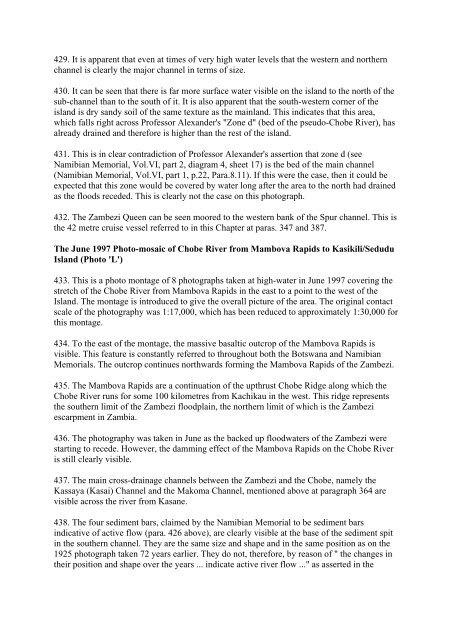botswana/namibia - Cour international de Justice
botswana/namibia - Cour international de Justice
botswana/namibia - Cour international de Justice
Create successful ePaper yourself
Turn your PDF publications into a flip-book with our unique Google optimized e-Paper software.
429. It is apparent that even at times of very high water levels that the western and northern<br />
channel is clearly the major channel in terms of size.<br />
430. It can be seen that there is far more surface water visible on the island to the north of the<br />
sub-channel than to the south of it. It is also apparent that the south-western corner of the<br />
island is dry sandy soil of the same texture as the mainland. This indicates that this area,<br />
which falls right across Professor Alexan<strong>de</strong>r's "Zone d" (bed of the pseudo-Chobe River), has<br />
already drained and therefore is higher than the rest of the island.<br />
431. This is in clear contradiction of Professor Alexan<strong>de</strong>r's assertion that zone d (see<br />
Namibian Memorial, Vol.VI, part 2, diagram 4, sheet 17) is the bed of the main channel<br />
(Namibian Memorial, Vol.VI, part 1, p.22, Para.8.11). If this were the case, then it could be<br />
expected that this zone would be covered by water long after the area to the north had drained<br />
as the floods rece<strong>de</strong>d. This is clearly not the case on this photograph.<br />
432. The Zambezi Queen can be seen moored to the western bank of the Spur channel. This is<br />
the 42 metre cruise vessel referred to in this Chapter at paras. 347 and 387.<br />
The June 1997 Photo-mosaic of Chobe River from Mambova Rapids to Kasikili/Sedudu<br />
Island (Photo 'L')<br />
433. This is a photo montage of 8 photographs taken at high-water in June 1997 covering the<br />
stretch of the Chobe River from Mambova Rapids in the east to a point to the west of the<br />
Island. The montage is introduced to give the overall picture of the area. The original contact<br />
scale of the photography was 1:17,000, which has been reduced to approximately 1:30,000 for<br />
this montage.<br />
434. To the east of the montage, the massive basaltic outcrop of the Mambova Rapids is<br />
visible. This feature is constantly referred to throughout both the Botswana and Namibian<br />
Memorials. The outcrop continues northwards forming the Mambova Rapids of the Zambezi.<br />
435. The Mambova Rapids are a continuation of the upthrust Chobe Ridge along which the<br />
Chobe River runs for some 100 kilometres from Kachikau in the west. This ridge represents<br />
the southern limit of the Zambezi floodplain, the northern limit of which is the Zambezi<br />
escarpment in Zambia.<br />
436. The photography was taken in June as the backed up floodwaters of the Zambezi were<br />
starting to rece<strong>de</strong>. However, the damming effect of the Mambova Rapids on the Chobe River<br />
is still clearly visible.<br />
437. The main cross-drainage channels between the Zambezi and the Chobe, namely the<br />
Kassaya (Kasai) Channel and the Makoma Channel, mentioned above at paragraph 364 are<br />
visible across the river from Kasane.<br />
438. The four sediment bars, claimed by the Namibian Memorial to be sediment bars<br />
indicative of active flow (para. 426 above), are clearly visible at the base of the sediment spit<br />
in the southern channel. They are the same size and shape and in the same position as on the<br />
1925 photograph taken 72 years earlier. They do not, therefore, by reason of " the changes in<br />
their position and shape over the years ... indicate active river flow ..." as asserted in the

















